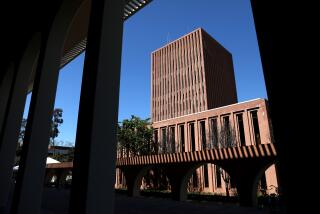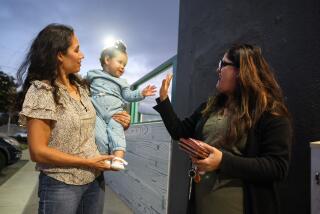Virtual Technology Provides Real Education
- Share via
MONTERREY, Mexico — Professor Socorro Marcos, a department head at Monterrey Technical Institute, was chatting recently with two postgraduate students. Julio Larios asked her to serve on his thesis committee, while Juan Carlos Cielo Flores had questions about a paper’s final draft.
During these discussions, Larios was in Honduras, Cielo Flores was at his office in Peru, and the professor never left her desk at the Monterrey Tech campus in this northern Mexican city.
They are pioneers of Virtual University, a Monterrey Tech project that promises to help Latin America narrow the education gap that has kept the region lagging behind the developed world. Since its launch in 1996, Virtual University--known by its initials in Spanish, UV--has blended cutting-edge technologies with innovative teaching approaches to prepare Spanish-speaking students to compete in the global economy.
UV says it already produces and transmits via satellite more live classroom hours--more than 240 a week--than any other distance-learning institution in the world, serving more than 40,000 students in Mexico and elsewhere in Latin America.
Now UV is building on the decade-long experience of Monterrey Tech--an aggressive private university that is often called the MIT of Mexico--in educating students via satellite. UV is developing a more complex array of technologies that includes videoconferencing, the Internet, online quizzing and “virtual blackboards.”
In response to e-mail questions from The Times, the 40-year-old Larios replied from Honduras that UV allows him to keep working as an executive in a regional development bank while pursuing a master’s degree in information technology administration “that is not available in Honduras or anywhere else in Central America.”
“To receive a world-class education you no longer have to go live in another country,” Larios wrote in the virtual interview. “The distances have been shortened, and this is very important when the resources for learning are limited. In my opinion, this is a model to follow in other countries or regions.”
The fast-expanding Virtual University is offering more than elite--and at between $12,500 and $20,000 total cost, pricey--master’s degrees. Rector Carlos Cruz Limon’s ambitious goals include extending UV’s year-old effort to upgrade teachers’ knowledge--a program that trained 6,000 high school educators in seven countries via satellite in 1998--to reach at least 800,000 people throughout Latin America within two years.
“Soon, all of Latin America will be connected [electronically], so the opportunity is incredible to become one Latino village,” Cruz said. “Instead of needing 50 years to close the gap, we can shorten it to 20 years.”
Already, UV offers educational options ranging from conventional programs for corporate executives and 13 master’s degrees in management, engineering and education to a doctorate in education. Most students are from Mexico, but with enrollment growing more than 30% each of the past two years, more and more students “attend” from countries across Spanish-speaking Central and South America.
More a Studio Than Classroom
UV’s home is a glass tower on the edge of the Monterrey Tech campus. On the first floor, a professor is teaching in what is more a studio than a classroom. Students from Monterrey attend; but far more are taking part virtually, thanks to the four robot-controlled television cameras capturing the lecture. The professor is supported by high-tech graphics and an overhead camera to catch explanatory notes he scrawls on a pad during the class, a sort of virtual blackboard.
Jose Manuel Sanchez, director of UV’s master’s program in business administration, estimated that each satellite class requires 20 to 25 man-hours of work for each hour of transmission, with intensive preparation to keep the classes professional and compelling.
“Ten seconds of silence on TV is death,” he said. “So we have to be totally organized with graphics and other aids, and ready with contingency plans to fill gaps. This is the television formula--how to keep students intellectually seduced, and in that way involved in the program.”
Next door in the control room, six technicians produce and transmit this satellite class--a sign of the labor-intensive nature of high-quality virtual education. The support team for each course also includes an instructional design expert to help the professor design the course, a television producer, a graphic designer, a Web site designer and one assistant for every 15 students registered for the course, including the distant students.
The flashy technology did not necessarily translate into quality education at first.
“We started with what is now the prehistoric Virtual University,” said Felipe Avila, head of public relations. “A class similar to any other, with the professor on a platform a step above the students and just lecturing on camera. The technology was state-of-the-art, but the educational model was archaic.
“So we changed the methodology as well, to put the students in active roles. And we started to work with the Internet, with videoconferencing and multimedia, with CD-ROMs and group-centered distance learning,” Avila said, giving students more responsibility for shaping their learning, rather than passively listening.
“Now the professor no longer is just the imparter of information but the person who guides the student--and [the teacher] becomes the director of the movie, not the star. Instead, the student becomes the star.”
UV is a logical extension of Monterrey Tech’s aggressive culture. The school was founded in 1943 by the city’s hard-nosed business magnates to raise the education level of Mexico’s managers, engineers and technicians. Today it has nearly 70,000 students and 5,000 faculty, making it one of the largest private universities anywhere.
America Economia magazine last year judged its business school the best in Latin America, largely thanks to the entrepreneurial drive that infuses the university’s culture. By the mid-1980s, the private university had established branch campuses in more than two dozen cities across Mexico.
Then Monterrey Tech discovered that its own faculty was ill-equipped to meet the quality standards of developed countries, which it had vowed to achieve. The institute’s application to be accredited by the Southern Assn. of Colleges and Schools, a U.S. agency, was denied because only one-third of its faculty members had master’s or doctoral degrees.
Virtual University has its roots in that crisis. Monterrey Tech vowed to raise its faculty standards and earn accreditation; the challenge was how to do it short of shutting down all the campuses for a year or two while faculty members came to Monterrey to earn higher degrees.
The answer lay in providing satellite-based distance-learning courses for groups of faculty members at Monterrey Tech’s branch campuses so they could continue to teach while studying with the best professors at the main sites here and in Mexico City. The result was remarkable: In 1989, 38% of undergraduate courses were taught by faculty members with postgraduate degrees; that rose to 95% in 1996, and accreditation was granted.
Faculty Training Shaped Evolution
That faculty training program shaped UV’s evolution. Most other universities that once provided an education from a distance via old-fashioned mail have shifted to Internet-based training but are still geared for the individual. Monterrey Tech takes a school-to-school approach. It transmits classes from its major campuses to groups of students who attend at remote sites--its own branch campuses and, increasingly, partner institutions elsewhere in Latin America.
Students thus work with peers and see their teachers, at least on screen. They say this aspect is valuable. When the MBA program reduced the number of satellite classroom hours, students complained that they weren’t getting enough contact, and the program added more air time.
“It is a very ambitious and enterprising initiative. It is unique, really,” said Tony Bates, director of distance education and technology at the University of British Columbia in Canada, one of the partner institutions that is working with UV to develop new courses.
“In Latin America, 95% of faculty don’t have PhDs, so there’s a huge market for upgrading faculty through these methods,” said Bates, who is considered a specialist in high-tech distance education. “And there’s virtually nowhere, apart from the National Technological University in the States, with so many campuses that are so well-connected.”
Other Technologies Offer Support
Already, UV is changing after only three years of operation, a sign of just how fast the technologies are evolving.
While transmission of classes remains UV’s core teaching tool, the satellite program is now supported by a battery of other technologies. The Internet is playing a growing role; it allows, for example, real-time transmission of e-mail queries from remote sites to professors during the class.
Karina Astorga of Monterrey is one of 116 students in UV’s virtual MBA program, offered jointly with Thunderbird Graduate School near Phoenix. She said a major challenge “is to break the barrier of technology, achieved by direct contact with the professor and questioning during class time through tools like live e-mail. And they will throw quizzes at you, so you can’t fall asleep.”
When quizzed, students must answer via “yes” or “no” buttons at their desks in the receiving sites. Professors also create virtual office hours, when they are available for Internet newsgroup discussions with students. Professors must respond to e-mail within 24 hours.
The MBA classes are transmitted Friday evenings and all day Saturday. In between, students do individual assignments and virtual group work via the newsgroups, often with partners who live in other countries.
While the postgraduate programs are the more prestigious and high-tech, UV’s greatest potential impact for Latin America may well lie in its program to improve the skills of teachers. The Inter-American Development Bank is considering funding that would dramatically expand the pilot program to include primary as well as secondary school teachers.
Yolanda Cazares, coordinator of the year-old teacher project, said UV has joined with DirectTV, a major satellite television provider in Latin America, to deliver the signal to schools.
One of DirectTV’s owners, Grupo Cisneros of Venezuela, is helping schools set up dishes to receive the signal. In addition to attending 100 hours of satellite classes, the teachers take part in workshops, fieldwork and other modes of study.
“For the first time in their lives, many of these teachers have approached a computer,” said Cazares, who teaches a course on effective management of groups. “Many teachers were afraid. The hardest part has been to get people to face up to the technology.”
More to Read
Sign up for Essential California
The most important California stories and recommendations in your inbox every morning.
You may occasionally receive promotional content from the Los Angeles Times.













